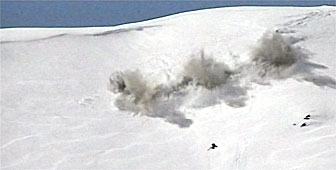Two die in avalanches over the New Year

Two people died in avalanches in Switzerland over the New Year, but a German mountaineer survived four days in the snow on the Jungfrau.
A 26-year old man from Basel was hit by an avalanche near Nendaz in Vaud while skiing off-piste. His companion managed to free herself, but the man was buried under two metres of snow. He was found by mountain rescue, but later died in hospital in Sion.
In Flumserberg in eastern Switzerland, the body of a 47-year-old skier, missing since Friday, was recovered from an avalanche on Monday.
On the same day, an avalanche on the Col des Chamois in Vaud hit six hikers. A woman from Lausanne was slightly injured and was taken to hospital in Monthey.
Luck was on the side of a 35-year-old German mountaineer, who was rescued on Sunday after surviving four days in freezing temperatures on the Jungfrau mountain in the Bernese Oberland.
The man had fallen into a crevasse, but managed to escape the cold by carving holes in the snow for shelter. He was finally able to reach a mountain hut, where he telephoned for help.
These recent avalanches have proved once again how the snowy peaks of the Swiss Alps can be a deadly playground for sports lovers.
Snow and Avalanche Research Institute
On average, 25 people die every year in avalanches, which usually are set off by skiers or climbers themselves. Most of the deaths could have been avoided if the victims had read the avalanche bulletins, and avoided taking risks on exposed slopes.
The Snow and Avalanche Research Institute in Davos, which opened in 1936, has a dedicated team of four forecasters, whose job it is to sift through several million pieces of data per month, and come up with bulletins detailing the avalanche risk in different parts of the Swiss Alps.
The institute begins issuing weekly bulletins in late September or early October. By mid November there are twice-daily reports, which continue through the end of April, when the bulletins become weekly again.
Weather stations
The team relies on information from seventy automatic, solar powered weather stations, posted in flat areas above two thousand metres, where avalanches are likely to start. These antenna-like devices measure air temperature, the surface temperature of the snow, and wind speed. By analysing the data, scientists at the Institute can estimate the snow drift, which helps them to evaluate the avalanche risk.
Human observers
The Institute also relies on information sent in daily by a team of 200 observers, who live in alpine valleys. The observers’ information is used for regional bulletins and for the less detailed national avalanche bulletins.
Some of the observers carry out snow profiling on steep slopes, to test the stability of the snow pack in a designated area. Others study how the snow crystals change over a period of weeks. This can also reveal how likely the snow pack is to move. The Institute also has access to weather forecasting models, satellite and radar images.
Different computer models are used to calculate the run-out distance of avalanches – how far they can move. The models help to improve hazard mapping in the Swiss Alps.
What causes avalanches?
Crystals on the surface of the snow undergo a metamorphosis, changing shape and losing cohesion.
When surface snow has low cohesion it is like sugar. New snow landing on top of it makes the snow pack unstable, and skiers can trigger avalanches very easily.
In Switzerland, the areas most at risk from destructive avalanches are the mountains towering above the Gotthard motorway and the approach road to Zermatt, which frequently has to be closed.
Danger levels
The bulletin compiled by the Institute is available by phone, fax, or on the Internet (www.slf.ch), in German, French and Italian. It breaks down the danger levels to five grades from small risk (number 1) to very big risk (number 5). On the Internet, this is displayed in the form of a map with regions coloured according to the danger level.
Green = 1 = small risk
Yellow = 2 = slight risk
Orange = 3 = considerable risk
Red = 4 = big risk
Red and black = 5 = very big risk
The most fatalities occur when the risk is considerable (number 3). Thomas Wiesinger, one of the forecasters, believes this is because skiers and climbers take more risks when they think the avalanche danger is reduced.
When the risk factor is at number 5, there is a danger of so-called destructive avalanches, which can knock down cable car supports, cover whole villages and sever major transport arteries. Local authorities in threatened areas often cordon off or evacuate whole sections of villages and roads when the risk reaches this level, but this is very rare.
Explosions are detonated under controlled conditions to artificially release avalanches before nature takes its toll. Pisted slopes in ski resorts – those which are controlled and flattened daily by machines like tractors – are not thought to be at risk from avalanches. It is the unpisted areas that are dangerous.
Avalanche danger warnings are posted on big flat screens in 17 ski stations around Switzerland.
The Institute’s website has 1.7 million hits per year, on average. The snow height map, rather than the bulletin, is the most popular element. It seems people are more interested in the depth of the snow in specific areas than the likelihood of meeting their maker whilst skiing there.
Worst avalanches
The two worst avalanche cycles in recent history occurred in 1951 and 1999.
In 1951 there were very few people living in the Swiss Alps, and hardly any tourists. Between January 16 and 20, up to two and a half metres of snow fell over northern Switzerland. This was topped by further one and a half metres in southern Switzerland between February 1 and 10. Some 1,000 avalanches in this period killed 75 people.
In 1999, 1,200 avalanches were triggered over a period of one month between January 29 and February 22, when more than five metres of new snow fell. The avalanches hit roads and settlements. Eleven of the 17 dead were in houses which collapsed. There were no skiers among the dead, as the ski lifts had been closed in the affected areas.
The damage would have been much worse if preventive structures such as galleries and barriers designed by the institute had not been put in place to block the path of the sliding snow slabs.
The avalanches occurred despite the fact that the snow pack was stable. It required a large amount of new snow to dislodge the pack.
Wiesinger says that although the number of skiers in the Alps has increased dramatically over the past 20 years, the number of fatalities has slightly decreased. This he attributes to accurate forecasting and the preventive efforts of the institute, working with the authorities in ski resorts.
Skier safety
The institute is also involved in testing materials and devices such as receivers, to increase the safety of skiers.
If each member of a skiing party carries a receiver and an avalanche victim is not completely buried, it may be possible to track him/her using one of the devices, which cost about SFr 400. Training is required in using the devices.
Even after locating a buried person, the rescue team has to work quickly to dig the victim out before they die of hypothermia or suffocation. Fifty percent of skiers who are completely buried still die, despite wearing a beacon or receiver.
Avalanche Balloon
The avalanche balloon (ABS) can be folded into a rucksack. If the snow begins to slip, the wearer can pull a handle on the rucksack, which detonates an explosive and inflates the balloon. This takes two seconds.
The skier is then able to float on the surface of the sliding snow, and is unlikely to be buried.
The Davos ski school requires students and guides to wear ABS if skiing off piste. However, most ski guides in Switzerland do not use them.
Wiesinger says that although the chances of survival are enhanced by wearing the ABS, skiers equipped with air balloons tend to take more risks.
The risk
It is difficult to convince a person who loves to ski off piste in powder snow of the risks.
Wiesinger sums up.” It’s not that one should refrain, but people should not go on very steep slopes on certain days in the winter. It is important to check out these days. Our forecasts help with this, and there are only few days in winter where it is really dangerous”.
by Julie Hunt

In compliance with the JTI standards
More: SWI swissinfo.ch certified by the Journalism Trust Initiative

You can find an overview of ongoing debates with our journalists here . Please join us!
If you want to start a conversation about a topic raised in this article or want to report factual errors, email us at english@swissinfo.ch.